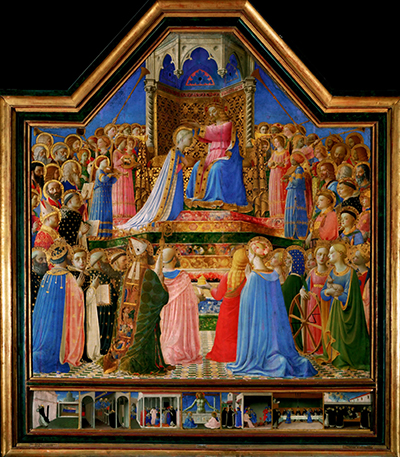Fra Angelico produced two paintings based around the Coronation of the Virgin, with this one now owned by the Louvre and the other in the Uffizi.
This version is believed to have been completed around two or three years after the other painting from the Uffizi, coming in 1434–1435, although all of his work is subject to estimation in terms of precise date and even which elements the artist completed with his own hand. Fra Angelico built up a solid team of assistants to help him to deliver such a large output of work but most of this scene is believed to have come directly from the master himself.
This painting makes use of more blue for the sky scene, where as the Uffizi version relies on gold finishes that dominates the non-active areas of the composition. This single change gives a very different finish to these paintings, even though the main areas of each composition is reasonably similar. Another difference is in size, with this Louvre painting being around twice the size at 213cm × 211cm.
One feature that is consistent in both is how he outlines the figures' heads with gold circles. That adds to a feeling of saintliness, which is ideal for this painting steeped in Christian themes.
The Louvre in Paris is a fitting location for one of Fra Angelico's most famous paintings and sits alongside some of the other great work from this influential period. A visit to this busy venue cannot be without a moment to appreciate the world famous Mona Lisa by Leonardo da Vinci but there are also impressive contributions to their collection from Caravaggio, Andrea Mantegna and Giovanni Bellini. This French institution also serves up the iconic Liberty Leading the People by Eugène Delacroix.




